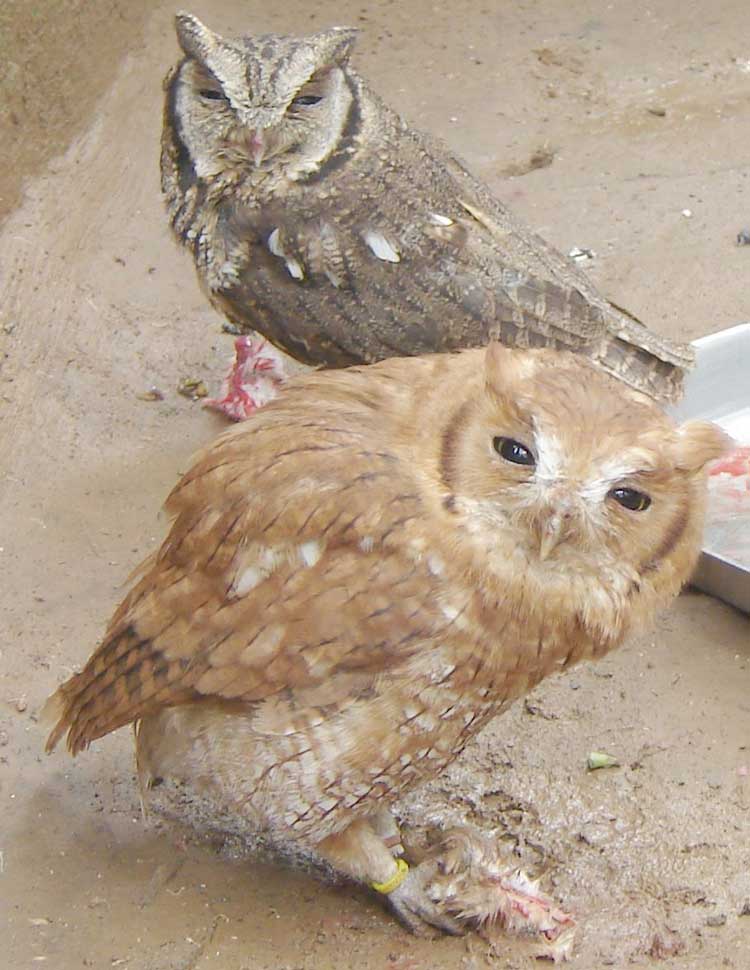Megascops choliba Cladus: Eukaryota Name Megascops choliba (Vieillot, 1817) Synonyms Otus choliba (Vieillot, 1817) Reference Nouveau Dictionnaire d'Histoire Naturelle Appliquée Aux Arts, principalement à l'Agriculture et à l'Economie rurale et domestique par une société de naturalistes et d'agriculteurs, avec des figures tirées des trois règnes de la nature. 7 p.39 Vernacular names
The Tropical Screech-owl (Megascops choliba) is a small species of owl in the Strigidae family.
It is found throughout South America (including Trinidad and Tobago), except in the Andes, the arid Pacific lowlands, and the far south. Its distribution also extends into southern Central America in Costa Rica and Panama. It is generally common – in large parts of its range among the most common species of owls and likely the most common screech owl of the tropics. It occurs in a wide range of wooded habitats, ranging from arid Caatinga to dense rainforest, and even city parks. Description This polymorphic species is highly variable in colour, it being overall grey-brown or (less commonly) brown or rufous, but always with a relatively distinctive blackish edge to the face and yellow irides. The length is 21-23 cm (8.3-9 in) long and weigh is 97-160 grams (3.4-5.7 oz). Subspecies M. c. choliba (Vieillot 1817): Occurs in southern Mato Grosso and São Paulo, Brazil, south to eastern Paraguay. M. c. luctisomus (Bangs and Pernard 1921): Occurs from the Pacific slope in Costa Rica south to the Canal Zone in Panama, and on the Pearl Islands. M. c. margaritae (Cory 1915): Restricted to Margarita Island off of northern Venezuela. Paler than nominate choliba. M. c. crucigerus (Spix 1824): Occurs from eastern Colombia, Venezuela, and Trinidad east to the Guianas and south to eastern Peru. Body feathers have fluffy yellowish spots. M. c. duidae (Chapman 1929): Confined to upper forested slopes of Mount Duida and Mount Neblina in southern Venezuela. This is a very dark subspecies with a rather uniform crown and a broken, whitish, collar on hindneck; this is the only subspecies of Tropical Screech-Owl with a white band across that back of the neck. Perhaps represents a separate species. M. c. decussatus (Lichtenstein 1823): Occurs in central and southern Brazil. Smaller and paler than crucigerus, with whitish spots on the mantle. M. c. uruguaiensis (Hekstra 1982): Occurs in southeastern Brazil (Santa Catarina, Rio Grande do Sul), northeastern Argentina and in Uruguay. Shaft streaks on underparts are rather prominent; body feathers with buffy-rufous downs. M. c. surutus (L. Kelso 1941): Found in Bolivia. Brighter rufous than crucigerus, and the streaks and bars are more reduced. M. c. wetmorei (Brodkorb 1937): Occurs in the chaco of Paraguay and Argentina, south to Mendoza and northernf Buenos Aires. Darker than decussatus and underparts more dirty-buff. Behavior Feeding The Tropical Screech-owl forages from a low level perch and captures prey on the ground, branches, or on wing. This species primarily preys on large arthropods, comprising about 66% of prey, and small vertebrates, comprising about 33%. Known invertebrate prey has included earthworms, scorpions, spiders, harvestmen, and a wide variety of insects, including roaches, termites, grasshoppers, katydids, raspy crickets, crickets, mole crickets, mantids and various beetles, moth, caterpillars and ants. Known vertebrate prey has included small frogs, small snakes, birds, opossums, bats and various rodents. Reproduction Males usually start singing in August or early September. Courtship mostly occurs in September. Males advertise possible nesting sites to females by flying to them and singing from the entrance. The clutch of 1 to 3 eggs (sometimes 6) are typically laid directly in natural cavities, abandoned bird nests, nest boxes, old woodpecker holes or even rotted-out fence posts. If feeling threatened during brooding, they will throw themselves flat on their back over the nestlings and extend their claws toward the intruder. In flight, they also will strike humans with their claws. The Tropical Screech Owl chicks are covered with white down, sparser on the dorsal area and their legs and feet were pale pink. The bill is pearl gray and has a white egg tooth. The nestlings eyes are closed at birth, but begin to open by the 6th day, and may not become fully open until the 10th day. Fledging occurs around 1 month of age. Source: Wikipedia, Wikispecies: All text is available under the terms of the GNU Free Documentation License |
|

